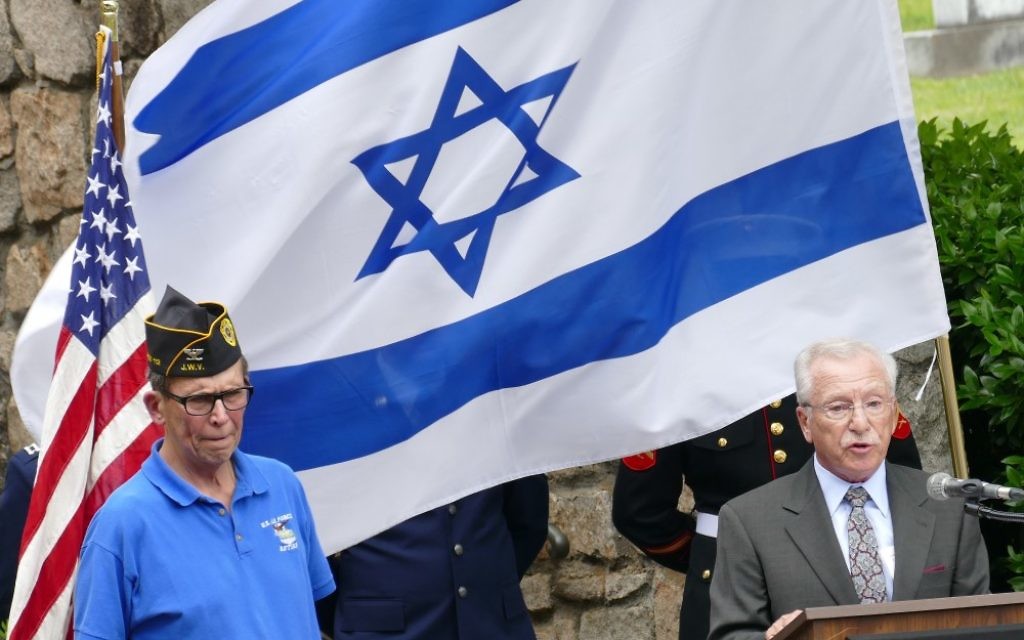Remembering the Children
Above: Robert Ratonyi, who survived World War II as a child in Budapest, delivers the keynote address while a breeze whips up the Israeli flag behind him at the 51st annual community Yom HaShoah commemoration at the Memorial to the Six Million at Greenwood Cemetery on Sunday, May 1. The ceremony focused on the children of the Holocaust — those who lived, those who died and those who were never born. Ratonyi, who was born 10 months before Kristallnacht, said it was half a century after the war before his mother told him he’s an only child because his parents couldn’t bear to bring another baby into Hitler’s world.
Several hundred people, including dozens of Holocaust survivors, withstood steamy conditions to join a tribute to the children affected by the Holocaust at the 51st annual Yom HaShoah commemoration at the Memorial to the Six Million at Greenwood Cemetery in Southwest Atlanta midday Sunday, May 1.

Heat rising into the 80s challenged members of Jewish War Veterans Post 112 who joined active-duty military personnel in standing watch with the U.S. and Israeli flags behind the speakers during the 90-minute program, and one audience member was briefly overcome and needed medical attention.
Get The AJT Newsletter by email and never miss our top stories Free Sign Up
But a year after steady rain fell on the memorial service — organized annually by Eternal Life-Hemshech with the Breman Museum, the Weinberg Center for Holocaust Education and the Jewish Federation of Greater Atlanta — the downpour didn’t come until after everyone had an opportunity to say Kaddish, place memorial stones and visit the names of relatives listed inside the monument.
Continuing a practice begun last year, each of the survivors at the ceremony got to light a memorial candle with the help of members of the Jewish Student Union.
But the ceremony focused on children who survived, who were killed and who were never born. Yom HaShoah committee chairwoman Jeannette Zukor noted that the technical definition of a child survivor is any survivor who was younger than 18 at the end of World War II, and 71 years after the liberation of the Nazi camps, few nonchild survivors remain.
Among the child survivors featured during the ceremony were the memorial’s architect, Benjamin Hirsch, who escaped Germany on the Kindertransport; one of the two vice chairmen of the Yom HaShoah committee, Hershel Greenblat, who was born in a cave in Ukraine while his parents were hiding and participating in the resistance to the Nazis; and featured speaker Robert Ratonyi, who was 6 when his mother was taken away in Budapest in October 1944 and spent two months hiding with his grandparents, aunts and cousins until they finally accepted life inside the ghetto, where the Soviet army later liberated them after his seventh birthday.
Ratonyi said he and his grandparents, who received protective passports from Swedish diplomat Raoul Wallenberg, moved seven times in two months, and each time he had to carry a hidden meat grinder that never saw any meat. The grinder became tougher and tougher for him to carry as he got weaker and weaker from malnutrition.
The key to the family’s survival during the two months in hiding was his 14-year-old cousin, Mike, who each night took off his yellow star and went scavenging through the war-torn city to find items that could be exchanged for food, Ratonyi said.
In the end, he lost his father and 13 other relatives to the Nazis, Ratonyi said, and he learned from his mother 50 years later that he never had a younger sibling because his parents couldn’t bear to bring another child into a world dominated by Adolf Hitler.
Ratonyi said he regrets being an only child, but his focus is on the future and ensuring that the past is not forgotten so that, as George Santayana warned, it will not be repeated. He also is haunted by a comment often attributed to Josef Stalin that a single death is a tragedy, while a million deaths are a statistic.
“Will the future remember the Holocaust as a statistic or millions of individual tragedies?” Ratonyi asked. He and other survivors speak about their experiences to influence the answer.
Photos by Michael Jacobs






comments